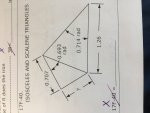TreasureDragon
New member
- Joined
- Nov 23, 2016
- Messages
- 12
Hello everyone,
I've found this forum to be strict yet helpful group and I am glad to come back! This time, I have two questions regarding Scalene Triangles and Circles.
The first question asks for the length of one of the sides when an isosceles and scalene triangles are put together with a few angles and sides given. I assumed this to be a question asking to use Sin or Cos rules but I cannot apply either as they do not meet the requirements to use them. Maybe it was Heron's formula, but to no avail, it was not.
The second question involves an inscribed circle within a scalene triangle. I have never in my life been able to solve a problem like this before. My only problem here is what the relation between the radius of the circle has with the angles/sides of the triangle.
Thank you for the help! PS Please disregard the attached file. Here's the link with both questions as I'm having issues uploading them directly here.
< links to objectionable pages removed >
I've found this forum to be strict yet helpful group and I am glad to come back! This time, I have two questions regarding Scalene Triangles and Circles.
The first question asks for the length of one of the sides when an isosceles and scalene triangles are put together with a few angles and sides given. I assumed this to be a question asking to use Sin or Cos rules but I cannot apply either as they do not meet the requirements to use them. Maybe it was Heron's formula, but to no avail, it was not.
The second question involves an inscribed circle within a scalene triangle. I have never in my life been able to solve a problem like this before. My only problem here is what the relation between the radius of the circle has with the angles/sides of the triangle.
Thank you for the help! PS Please disregard the attached file. Here's the link with both questions as I'm having issues uploading them directly here.
< links to objectionable pages removed >
Attachments
Last edited by a moderator:


